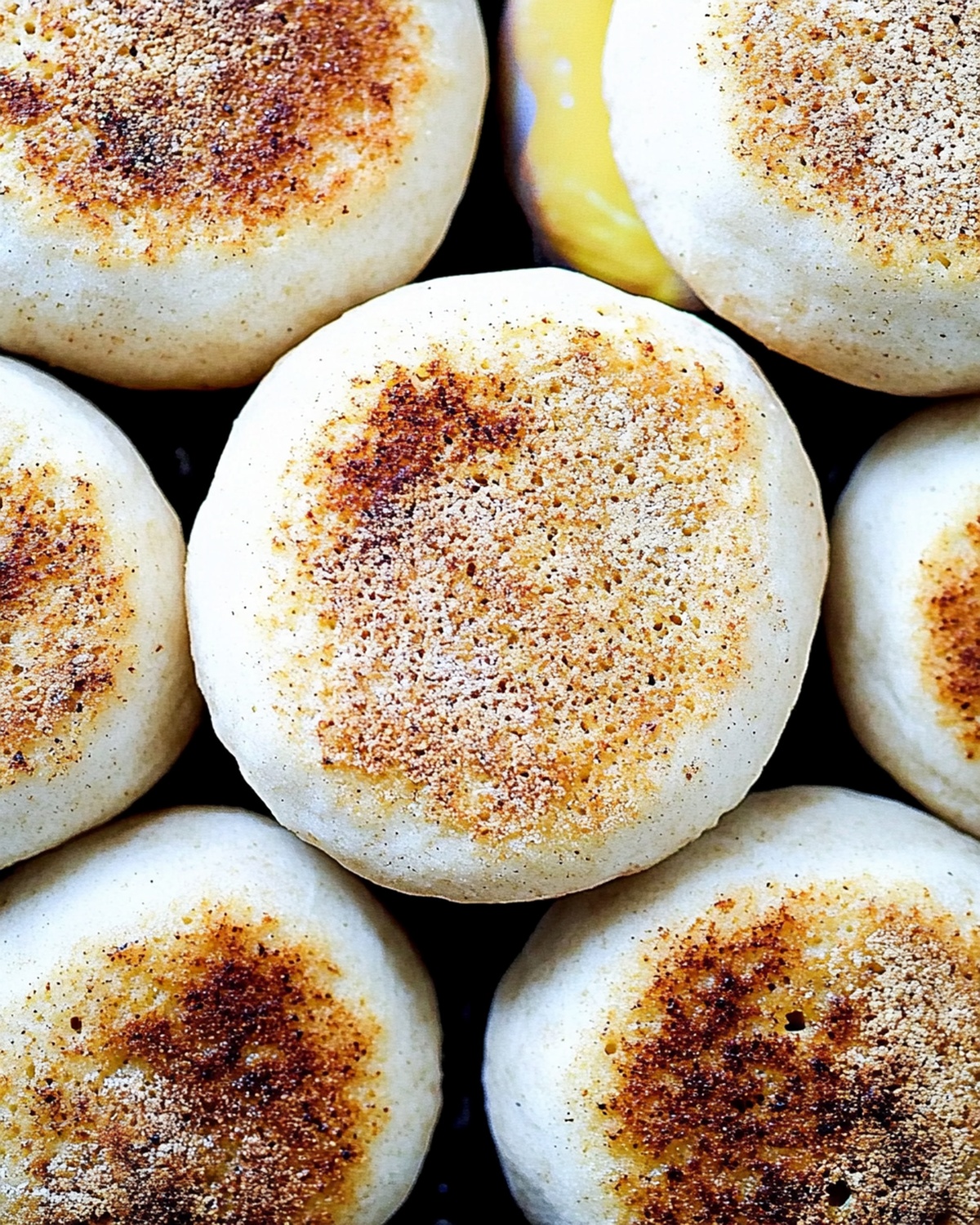Easy Homemade Sourdough English Muffins Recipe: Fluffy Morning Magic
Crafting delectable sourdough english muffins brings pure kitchen magic right to your countertop.
Baking these golden rounds connects you with generations of bread makers who perfected their craft.
Tangy fermentation creates complex flavors that commercial products simply cannot match.
Wild yeast works its incredible alchemy through patient culturing and gentle kneading.
Nooks and crannies emerge naturally, waiting to capture melted butter or jam.
Your morning breakfast will never feel the same after mastering these rustic rounds.
Dive into this simple yet transformative recipe that celebrates traditional bread making with modern flair.
What’s Great About Homemade Sourdough English Muffins
What Goes Into Homemade Sourdough English Muffins
Sourdough Base:Leavening and Seasoning:Cooking and Dusting:How To Prepare Homemade Sourdough English Muffins
Step 1: Blend the Starter Mixture
Grab a medium bowl and combine your tangy sourdough starter with creamy milk, sweet honey, and a generous portion of flour. Stir everything together until you create a smooth, unified mixture that hints at the deliciousness to come.
Step 2: Allow Fermentation Magic
Cover your bowl and let the mixture sit quietly at room temperature for 8–10 hours. This resting period allows wild yeast and bacteria to work their transformative magic, developing rich, complex flavors.
Step 3: Develop the Dough
Introduce baking soda and salt to your fermented mixture, then fold in additional flour. Knead the dough until it becomes silky and elastic. You can use a stand mixer for about 5 minutes or work it by hand for 10 minutes. Add extra flour if the dough feels too sticky.
Step 4: Rest and Relax
Give your dough a short break of 10–15 minutes. This allows the gluten to settle and makes rolling easier.
Step 5: Roll and Shape
Using a rolling pin, flatten the dough to about half an inch thick. This will create the perfect muffin foundation.
Step 6: Cut Circular Shapes
Grab a round cutter or a glass and create beautiful circular muffin shapes. Transfer these onto a baking sheet sprinkled with cornmeal, which adds a delightful texture.
Step 7: Maximize Your Yield
Don’t waste those dough scraps! Reroll and cut additional muffins. You’ll likely create 9 large or 18 smaller muffins.
Step 8: Final Rise
Loosely cover the muffins with greased plastic wrap. Let them rise and become puffy for about an hour.
Step 9: Prepare Cooking Surface
Warm up a griddle to 325°F or heat a pan over medium-low heat. Generously dust the surface with cornmeal for that classic crispy exterior.
Step 10: Cook to Perfection
Carefully place muffins on the heated surface. Cook each side for 5–6 minutes. If possible, cover the pan to ensure even cooking and that signature golden-brown color.
Step 11: Check Doneness
Use an instant-read thermometer to confirm the muffins’ internal temperature reaches 190°F. This guarantees they’re fully cooked and ready to enjoy.
Good Tips For Homemade Sourdough English Muffins
Ways To Mix Up Homemade Sourdough English Muffins
Best Pairings For Homemade Sourdough English Muffins
How To Store Homemade Sourdough English Muffins
Questions About Homemade Sourdough English Muffins
Check that your starter is bubbly, has a pleasant sour smell, and doubles in size within 4-8 hours after feeding. If it’s sluggish, feed it consistently for a few days before attempting the recipe.
Yes, you can use non-dairy alternatives like almond, oat, or soy milk. Just ensure they are at room temperature to help with fermentation and maintain similar consistency.
Resting allows gluten to relax, making the dough easier to handle and roll out. It also helps develop better texture and flavor in the muffins by allowing fermentation to continue.
Print
Homemade Sourdough English Muffins Recipe
- Total Time: 8 hours 30–32 minutes
- Yield: 8 1x
Description
Crusty, golden homemade sourdough English muffins bring rustic bakery charm straight to kitchen counters. Nooks and crannies promise delightful butter-catching surfaces that make breakfast mornings more delicious for hungry families.
Ingredients
Main Ingredients:
- 4 cups all-purpose flour (unbleached)
- 2 cups milk
- 1 cup active sourdough starter (100% hydration)
Leavening and Seasoning:
- 2 teaspoons salt
- 1 teaspoon baking soda
- 2 tablespoons honey
Dusting and Coating:
- 1–2 cups all-purpose flour (unbleached)
- Cornmeal (semolina, or farina for dusting)
Instructions
- Combine sourdough starter, milk, honey, and most of the flour in a medium bowl, mixing until a cohesive batter forms.
- Allow the mixture to ferment at room temperature for 8-10 hours, developing complex flavor and texture.
- Incorporate baking soda, salt, and remaining flour, kneading the dough until it becomes smooth and elastic, approximately 5-10 minutes depending on the method.
- Let the dough rest briefly to relax the gluten and improve workability.
- Gently roll out the dough to a uniform 1/2-inch thickness on a lightly floured surface.
- Cut precise circles using a round cutter or glass, placing them on a cornmeal-dusted, greased baking sheet.
- Gather and re-roll dough scraps to maximize muffin yield, creating approximately 9-18 muffins.
- Cover muffins loosely with greased plastic wrap and allow them to rise for about 1 hour at room temperature.
- Heat griddle to 325°F or prepare a pan over medium-low heat, generously sprinkling with cornmeal to prevent sticking.
- Cook muffins in batches, allowing 5-6 minutes per side and covering the pan to ensure even heat distribution.
- Verify doneness by checking the internal temperature reaches 190°F using an instant-read thermometer.
Notes
- Work with cold starter straight from the refrigerator for better texture and more controlled fermentation.
- Use whole milk or buttermilk for richer flavor and softer muffins.
- Dust cutting surface and tools with flour to prevent sticky dough from clinging.
- Avoid overworking the dough to maintain tender, light muffins.
- Cook muffins slowly on low heat to ensure even golden-brown exterior and fully cooked interior.
- Allow muffins to cool completely before splitting with a fork to create signature nooks and crannies.
- Store cooled muffins in an airtight container at room temperature for 3-4 days or freeze for up to 2 months.
- For gluten-free option, substitute all-purpose flour with a 1:1 gluten-free flour blend and add xanthan gum.
- Prep Time: 8 hours 20 minutes
- Cook Time: 10–12 minutes
- Category: Breakfast, Lunch, Snacks
- Method: Sautéing
- Cuisine: American
Nutrition
- Serving Size: 8
- Calories: 150 kcal
- Sugar: 3 g
- Sodium: 300 mg
- Fat: 1.5 g
- Saturated Fat: 0.9 g
- Unsaturated Fat: 0.6 g
- Trans Fat: 0 g
- Carbohydrates: 30 g
- Fiber: 1 g
- Protein: 6 g
- Cholesterol: 10 mg


Michael Thompson
Founder & Recipe Developer
Expertise
Education
Cascade Culinary Institute – Bend, OR
ServSafe Food Handler Certification – Portland, OR
Focus: Certified in core food safety and hygiene principles for both home and professional kitchens, with emphasis on ingredient handling, kitchen cleanliness, and safe preparation methods.
Mike’s kitchen journey began with a single goal: to make everyday meals feel like something worth celebrating.
After earning his Certificate in Culinary Arts from Cascade Culinary Institute, he spent years working with local farmers and small kitchens across Oregon, learning the beauty of seasonal, small-batch cooking.
Mike’s approach is simple, cook with what’s fresh, keep it approachable, and always leave room for a little creativity. When he’s not testing yogurt marinades or designing single-serving meals, you’ll find him hiking trails or hunting down the best berries at local markets.